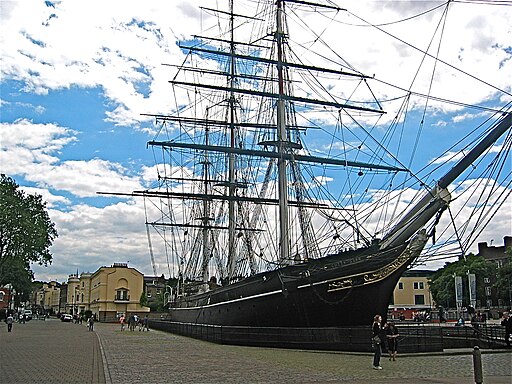At the heart of maritime history lies a legendary vessel known for her speed and endurance, a ship that has written numerous stories on the waves of the world’s oceans: the Cutty Sark. This British clipper ship, a symbol of the Age of Sail, is one of the most famous sea vessels in the world, captivating visitors with its storied past and unique architecture. Read on to learn about the extraordinary legacy of the Cutty Sark, its significant contribution to maritime trade, and how it stands today as an enduring symbol of Britain’s maritime heritage.
The Birth of a Legend
The Cutty Sark was launched in 1869 from the shipyard of Scott & Linton in Dumbarton, Scotland. Hercules Linton designed her for the challenging and highly competitive tea trade between China and Britain. Her unique design, a composite construction of wood planking over an iron frame, combined the best of the old and the new, setting the stage for her to become the fastest ship of her era.
Speed and Endurance
In the mid-19th century, clipper ships like the Cutty Sark were the pinnacle of fast maritime travel. They were particularly prized for their speed. The Cutty Sark quickly earned a reputation as one of the fastest tea clippers, routinely making the voyage from China to London in under 100 days. However, her real moment of glory came during the wool trade from Australia, where she set several records for her incredible speed, including a record-breaking passage of just 73 days from Sydney to London.
Surviving the Storms
The Cutty Sark’s history is as turbulent as the seas she sailed. With the opening of the Suez Canal in 1869 and the advent of steamships, sailing ships like the Cutty Sark began to decline. After the 1870s, she was used in the wool trade before becoming a training ship in the early 20th century. Remarkably, the Cutty Sark survived both World Wars, multiple changes of ownership, and the general obsolescence of sailing vessels.
A Living Museum
Today, the Cutty Sark is a testament to the past and a living piece of history. In 1954, she was transferred to a permanent dry dock at Greenwich, London, becoming a public museum for all to enjoy. Even after an unfortunate fire in 2007, the Cutty Sark rose like a phoenix, undergoing extensive restoration and reopening in 2012. She now stands proudly as the last surviving tea clipper and the fastest ship of her era, offering a tangible connection to our maritime past.
Cutty Sark’s fame lies in her speed, design, resilience, and endurance. Over a century and a half after her launch, she continues to inspire and educate, reflecting the spirit of innovation, daring, and exploration that characterized the great Age of Sail. Whether you’re a history enthusiast, a maritime aficionado, or simply someone who appreciates remarkable stories, the tale of the Cutty Sark is a journey well worth taking.
For more insights into the Cutty Sark and other important historic ships, planes, and vehicles, visit Aces In Action. Here, you’ll find an amazing piece of artwork by Craig Tinder titled “Cutty Sark,” that depicts the historic clipper ship – “Cutty Sark” on the high seas. The limited edition canvas print even includes a section of plating was removed from the ship before the ship was engulfed in fire in 2007.
Cutty Sark – Clipper Ship Maritime Art Print by Artist Craig Tinder
The Cutty Sark is a 19th-century British clipper ship that was one of the fastest ships of it’s time. She was built in 1869 to transport tea from China to England and later held many speed records hauling wool from Australia.
The ship’s speed and efficiency is considered the peak of sail technology, which allowed her to outrun many early steamships. But when the Suez Canal opened, steamships eventually became the preferred means of transporting goods across the oceans.
The Cutty Sark is now a museum ship, permanently moored in Greenwich, London, and is considered a symbol of the golden age of sail.


